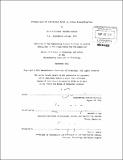Production of levulinic acid in urban biorefineries
Author(s)
Sheldon-Coulson, Garth Alexander
DownloadFull printable version (5.032Mb)
Other Contributors
Massachusetts Institute of Technology. Technology and Policy Program.
Advisor
Kenneth A. Oye.
Terms of use
Metadata
Show full item recordAbstract
The energy security of the United States depends, most experts agree, on the development of substitute sources of energy for the transportation sector, which accounts for over 93% of the nation's petroleum consumption. Although great strides have been made in the development of electric vehicles and associated generation and transmission platforms, technical and economic considerations dictate that the transportation sector will rely preponderately on organic fuels for the foreseeable future. The U.S. Department of Energy and U.S. Department of Agriculture have therefore indicated that integrated cellulosic biorefineries, whose feedstock is abundant lignocellulosic plant matter rather than scarce starch, are a vital area for research, development, and commercialization. This thesis evaluates the commercial viability of cellulosic biorefineries in and near the nation's urban centers, where significant volumes of carbohydrate feedstock are already concentrated, collected, and hauled as municipal and commercial wastes and therefore available to commercial users at negative cost. The case evaluated is a prospective demonstration-scale facility located in the urban corridor linking New York and Philadelphia, where "tipping fees" received for redirecting urban waste from landfills are the highest in the nation. The chosen conversion platform, a mature technology called the Biofine Process that has not previously been commercialized, uses acid-catalyzed hydrolysis of the carbohydrate feedstock to produce levulinic acid, a noted "platform chemical" that provides three main benefits: (1) convertibility from diverse and heterogeneous carbohydrate feedstocks containing the high moisture levels characteristic of putrescible wastes, (2) high conversion yields using the chosen conversion platform, and (3) a wide variety of downstream synthetic transformations to valuable derivatives, including fuels. Co-products include formic acid and furfural. In order to evaluate the economic underpinnings of such a facility, the chosen conversion platform is described on the basis of publicly available documents and modeled using a novel domain-specific language (DSL) and symbolic solution library developed for this thesis. This software tool is used to determine the dynamic equilibrium conditions of the process flow of the chemical plant, including net throughput and energy consumption. Such a tool is required because the process flow of the chosen conversion platform feeds back on itself by recycling hydrolysate and acid catalyst, mandating simultaneous solution. A financial model is presented on the basis of the equilibrium process model showing that public support for such a project is required at the vital demonstration scale. The significant public policy benefits associated with urban biorefineries that can divert putrescible wastes from landfills are therefore shown in this case to depend on public support. In order to estimate the appropriate level of subsidy, external environmental and security benefits are quantified. A study of past federal funding patterns ultimately shows that this level of funding is unlikely to accrue to urban projects without changes in the rural emphasis of current policy and public administration.
Description
Thesis (S.M. in Technology and Policy)--Massachusetts Institute of Technology, Engineering Systems Division, Technology and Policy Program, 2011. Cataloged from PDF version of thesis. Includes bibliographical references (p. 81-84).
Date issued
2011Department
Massachusetts Institute of Technology. Engineering Systems DivisionPublisher
Massachusetts Institute of Technology
Keywords
Engineering Systems Division., Technology and Policy Program.